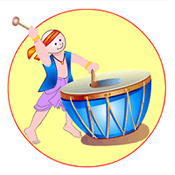
Dimdima
Online Children's Magazine from India

Dimdima
Online Children's Magazine from India
By Rani Iyer

Swamps, marshes, backwaters, mangroves, estuaries, vernal pools, and inter tidal zones are some wetland formations. Wetlands vary widely because of regional and local differences in soils, topography, climate, hydrology, water chemistry, vegetation, and other factors, including human disturbance. Wetlands are found from the tundra to the tropics and on every continent except Antarctica. These natural formations are in danger today. They are endangered by human activities, water pollution, and fragmentation.
Wetlands support many species of fishes, plants, birds, and other creatures that are unique to the area. Some wetlands are seasonal and people depend on them for their livelihood. All over the world the loss of wetlands is causing alarm to the environmental scientists.
For, the destruction of habitat in one location could mean the disruption of life in many other parts of the world.
This example is illustrated with migratory visitors to Indian wetlands. Species like flamingos, spoonbills, geese, cranes, storks, and many species of ducks that come from various parts of the world utilize the wetlands as breeding grounds. In some species, the fledglings and juveniles stay for a year until they are strong enough to fly. Several species of grasses, brushes, bamboo, and other perennial plants are also unique to the wetlands.
The chances are that there is a wetland close to where you live in one form or another. You will see it being lost when they are filled and reclaimed for building houses or roads. Perhaps the earliest example of human interference in wetlands, when man reclaimed the land, is found in the Puranas when Parashurama reclaimed the land that later became Kerala. Most port cities in India are built on reclaimed land. What remains today is only a fraction of what existed.
We can live with the fact that a single species is endangered, but to hear the threat to an entire ecosystem is frightening. We can save the existing fragments of wetlands by taking active interest in the diversity of life that inhabits there. Observing only a single aspect of the life there, like birds, insects, or plants, can also provide information. Such data is needed for planning conservation and enforcing protection to the area. Every contribution is important and significant for the survival of the smallest piece of wetland today! You too can make a contribution in saving the wetlands by observing and recording the events in them. Join the World Wetland Day celebrations on 2 February every year.
Last updated on :9/23/2003
EXPLORE MORE...
COMMENT ON THIS ARTICLE
Wants to share something related to this article? Please use the form below.
Dimdima is the Sanskrit word for ‘drumbeat’. In olden days, victory in battle was heralded by the beat of drums or any important news to be conveyed to the people used to be accompanied with drumbeats.
Bharatiya Vidya Bhavan
K. M Munshi Marg,
Chowpatty, Mumbai - 400 007
email : editor@dimdima.com
Bharatiya Vidya Bhavan
505, Sane Guruji Marg,
Tardeo, Mumbai - 400 034
email : promo@dimdima.com
Dimdima.com, the Children's Website of Bharatiya Vidya Bhavan launched in 2000 and came out with a Printed version of Dimdima Magazine in 2004. At present the Printed Version have more than 35,000 subscribers from India and Abroad.